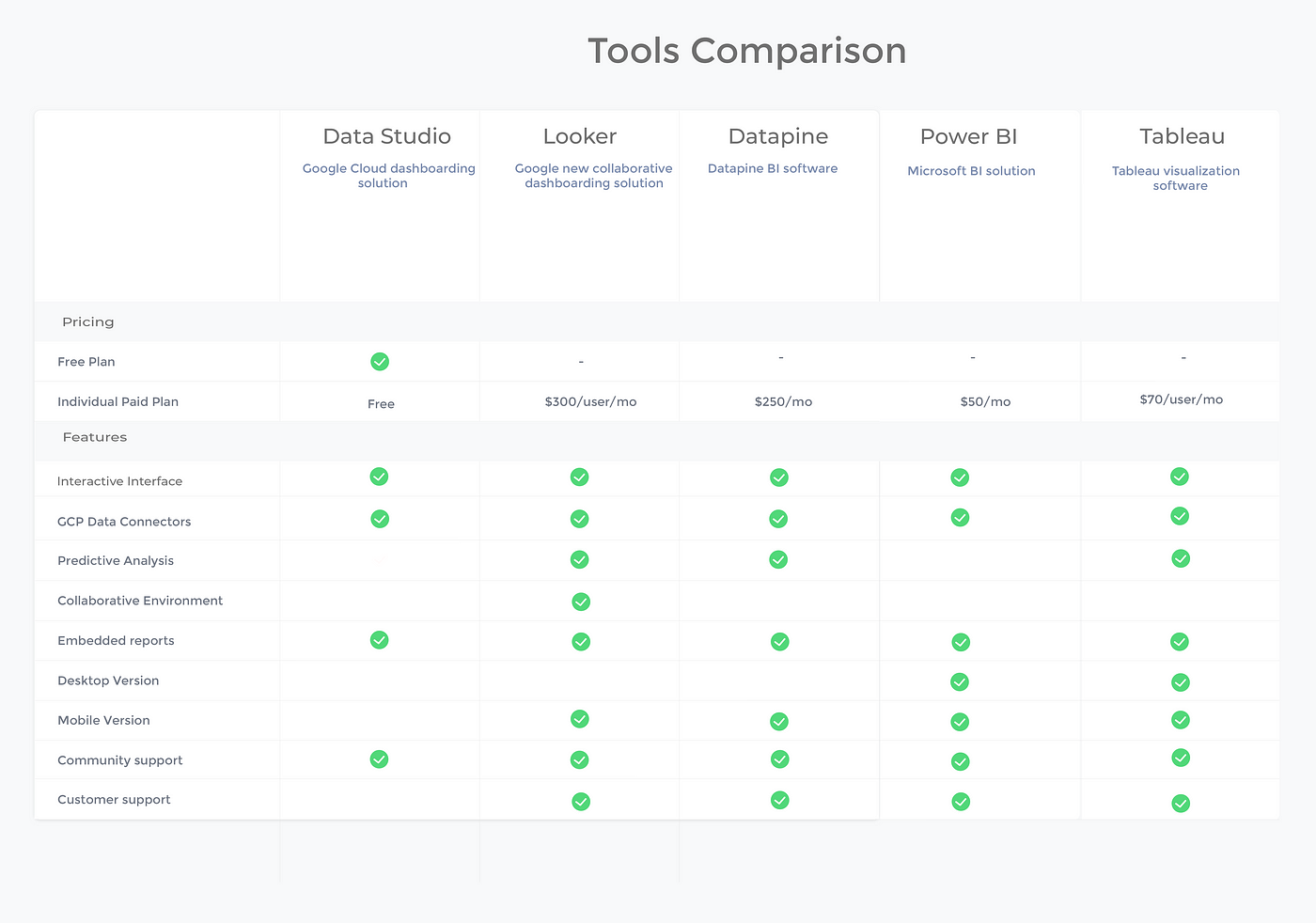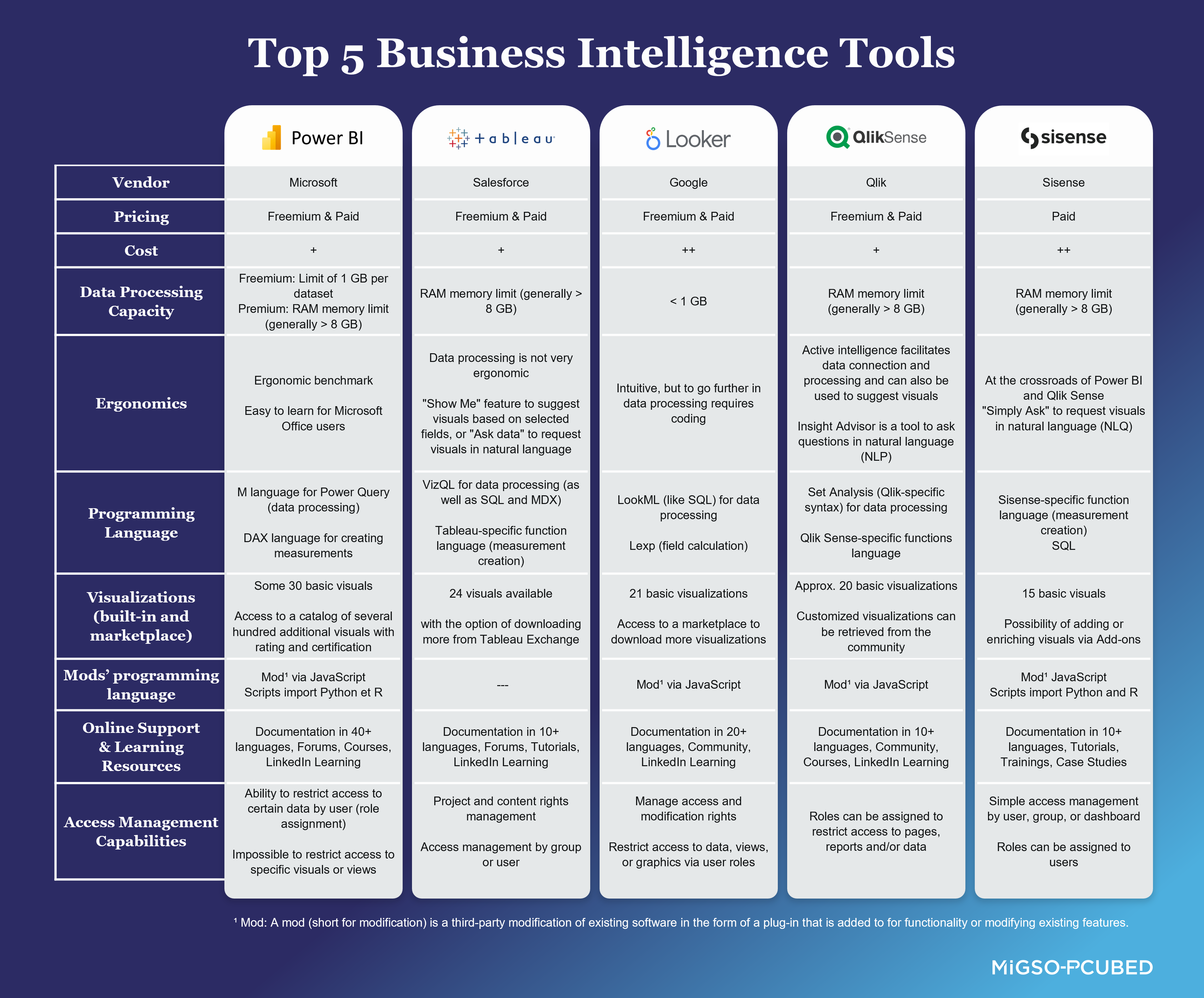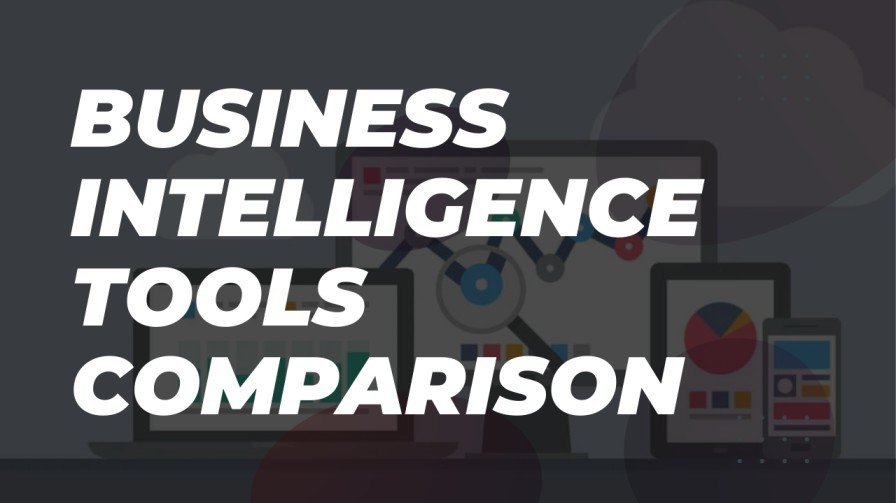Power BI, Tableau, and Qlik Sense are leading business intelligence tools. Each offers unique features, strengths, and pricing models.
Business intelligence tools transform raw data into insightful reports and dashboards. They empower decision-makers with actionable insights. Power BI, Tableau, and Qlik Sense dominate the BI landscape. Power BI integrates well with Microsoft products, offering robust features at a competitive price.
Tableau is renowned for its data visualization capabilities and ease of use. Qlik Sense stands out with its associative data model and self-service analytics. Choosing the right tool depends on your specific needs, budget, and technical environment. Proper evaluation ensures the selected tool aligns with your business goals and enhances data-driven decision-making.
Key Features Of Bi Tools
Business Intelligence (BI) tools are vital for turning raw data into actionable insights. These tools help businesses make informed decisions, streamline operations, and gain a competitive edge. A business intelligence tools comparison reveals that the key features of BI tools significantly impact their effectiveness and usability. Let’s dive into the critical aspects of BI tools, focusing on data visualization, reporting capabilities, and integration options.
Data Visualization
Data visualization is a cornerstone feature in the business intelligence tools list. It transforms complex data sets into visual formats like charts, graphs, and dashboards. This makes data easier to understand and analyze.
- Clarity: Visuals make data trends and patterns more apparent.
- Speed: Quick interpretation of large data sets.
- Interactivity: Users can interact with data through filters and drill-downs.
For a business intelligence tools comparison, look at how each tool handles data visualization. Some tools excel in creating interactive dashboards, while others focus on static reports.
Example Comparison Table:
| Tool | Visualization Types | Interactivity |
|---|---|---|
| Tool A | Charts, Graphs, Maps | High |
| Tool B | Charts, Dashboards | Medium |
| Tool C | Graphs, Tables | Low |
Reporting Capabilities
Reporting capabilities are crucial in the top business intelligence tools. Reports provide detailed and structured data insights. Businesses rely on these reports for strategic planning and decision-making.
- Customization: The flexibility to modify reports to meet specific requirements.
- Automation: Automatically generated reports save time.
- Distribution: Easy sharing and distribution of reports.
A business intelligence tools comparison chart should highlight the reporting strengths of each tool. Some tools offer extensive customization options, while others focus on automation and ease of distribution.
Integration Options
Integration options are vital for any business intelligence tools comparison. Businesses need their BI tools to integrate seamlessly with existing systems and data sources.
- Data Sources: Ability to connect to various databases and data warehouses.
- APIs: Support for APIs to integrate with other software.
- Third-party Applications: Compatibility with popular third-party applications.
The business intelligence tools list includes tools with different integration strengths. Some tools are versatile, integrating with numerous data sources and third-party apps. Others may focus on specific ecosystems.
Example Comparison Table:
| Tool | Data Sources | APIs | Third-party Apps |
|---|---|---|---|
| Tool A | Wide Range | Supported | Many |
| Tool B | Limited | Not Supported | Few |
| Tool C | Moderate | Supported | Several |

Credit: medium.com
Top Bi Tools In 2023
Business intelligence tools have become essential in today’s data-driven world. Companies need them to make informed decisions. The business intelligence tools list is vast, but we’ll focus on the top BI tools in 2023. This business intelligence tools comparison will help you pick the best one for your needs.
Tableau
Tableau is one of the top business intelligence tools in 2023. It’s known for its powerful data visualization capabilities. Users can create detailed and interactive dashboards. Tableau is versatile, as it supports a wide range of data sources.
Key features of Tableau include:
- Data Blending: Combine data from multiple sources.
- Real-Time Analysis: Immediate insights from live data.
- Interactive Dashboards: User-friendly and customizable.
Tableau’s ease of use is a major advantage. Even non-tech users can create complex visualizations. This makes it popular in many industries. The community support and regular updates keep it ahead in the business intelligence tools comparison chart.
Power Bi
Power BI by Microsoft is another top contender. It provides a full suite of business analytics tools. Power BI is particularly recognized for its seamless integration with other Microsoft products. This makes it a preferred choice for businesses already using Microsoft services.
Key features of Power BI include:
- Seamless Integration: Works well with Excel and Azure.
- AI Capabilities: Advanced analytics with artificial intelligence.
- Mobile Access: Dashboards accessible on mobile devices.
Power BI provides robust data security. It ensures that sensitive data is protected. Users can create detailed reports and share them easily. This tool stands out in the business intelligence tools list for its affordability and extensive features.
Qlik Sense
Qlik Sense is a user-friendly BI tool. It is known for its associative data model. This model allows users to explore data without predefined queries. Qlik Sense supports self-service data discovery, making it a favorite among analysts.
Key features of Qlik Sense include:
- Associative Model: Explore data freely without constraints.
- Self-Service Analytics: Empower users to analyze data independently.
- Smart Visualizations: Automatically suggest the best visualizations.
Qlik Sense offers robust data integration. It can connect to various data sources seamlessly. The tool also provides strong data governance features. In the business intelligence tools comparison chart, Qlik Sense is noted for its flexibility and innovative approach to data analysis.
Pricing Models
Comparing business intelligence tools often requires a detailed look at their pricing models. Pricing is a critical factor that can influence the final decision. Different tools offer varied pricing structures that cater to diverse business needs. Below, we explore the various pricing models of business intelligence tools, helping you navigate through the options available.
Subscription Vs. One-time Fees
When evaluating business intelligence tools, you will encounter two primary pricing models: subscription-based and one-time fees. Subscription-based models require ongoing payments, typically monthly or annually. This model ensures continuous updates and support. Below are some important points to take into account:
- Monthly Subscriptions: Suitable for businesses with flexible budgets and a need for regular updates.
- Annual Subscriptions: Typically offer discounts, making them a cost-effective option for long-term use.
One-time fees involve a single payment for lifetime access. This option can be beneficial for businesses that prefer a one-off expense. Consider these factors:
- Upfront Cost: Higher initial cost, but no recurring payments.
- No Ongoing Fees: Ideal for businesses with limited budgets for software subscriptions.
The following is a comparison table for improved clarity:
| Pricing Model | Cost | Updates | Support |
|---|---|---|---|
| Subscription | Recurring | Regular | Included |
| One-Time Fee | One-off | Occasional | May require extra fees |
Free Trials And Demos
Many top business intelligence tools offer free trials and demos. These allow potential users to test the software before committing financially. Free trials typically last from 7 to 30 days, giving users ample time to explore features and functionalities. Key benefits include:
- Hands-On Experience: Evaluate the tool in a real-world environment.
- Feature Testing: Determine if the tool meets specific business needs.
Demos are often guided tours provided by the vendor. They showcase the tool’s capabilities and how it can solve business problems. Important aspects to note:
- Guided Walkthrough: Understand key features with expert guidance.
- Q&A Sessions: Ask specific questions to clarify doubts.
Both free trials and demos are invaluable for making an informed decision. They reduce the risk of investing in a tool that may not meet your needs. Always take advantage of these offers when comparing business intelligence tools.
Cost-effectiveness
Assessing the cost-effectiveness of business intelligence tools is crucial. It’s not solely about the price; it’s about the value you gain. Consider the following factors:
- Feature Set: Does the tool provide all the necessary features to meet your requirements?
- Scalability: Can the tool grow with your business?
- Support and Training: Is there adequate support and training available?
Some tools may seem expensive initially but offer significant long-term savings. For instance, a higher-priced tool with robust features can eliminate the need for additional software. Here’s how to evaluate cost-effectiveness:
- ROI Calculation: Estimate the return on investment by comparing the tool’s cost to the benefits it provides.
- Hidden Costs: Be aware of any additional costs for updates, support, or add-ons.
Using a business intelligence tools comparison chart can help visualize cost-effectiveness. Make sure to list all potential costs and benefits to make an informed decision. Investing in the right business intelligence tool can lead to improved efficiency and significant cost savings over time.
User Experience
Choosing the right business intelligence tools can be challenging. A critical factor in the decision-making process is the user experience. This impacts how efficiently your team can operate. Let’s dive into the key aspects of user experience in a business intelligence tools comparison.
Ease Of Use
Ease of use is crucial in any business intelligence tools comparison. A tool should be intuitive and simple to navigate. Users should perform tasks without excessive training. Here’s a look at some top business intelligence tools:
| Tool | Ease of Use Rating |
|---|---|
| Tableau | ⭐⭐⭐⭐⭐ |
| Power BI | ⭐⭐⭐⭐ |
| QlikView | ⭐⭐⭐ |
Tableau is renowned for its user-friendly interface. Users drag and drop elements to create visualizations. Power BI follows closely with a straightforward dashboard. QlikView, though powerful, comes with a steeper learning curve.
Learning Curve
The learning curve is a significant factor in selecting a tool from the business intelligence tools list. A steep learning curve may hinder productivity. Here’s a look at the learning curves for some top business intelligence tools:
- Tableau: Easy for beginners. Requires minimal training. Extensive community support.
- Power BI: Moderate. Users need some time to master advanced features.
- QlikView: Steep. Advanced users benefit the most. Requires significant training.
Tableau offers numerous tutorials and a vibrant community. This makes it easy for new users. Power BI provides a balance, with accessible starter guides and detailed documentation. QlikView targets advanced users. It has extensive training programs.
Customer Support
Effective customer support enhances the user experience. This is essential in a business intelligence tools comparison chart. Effective support can swiftly and efficiently resolve issues. Here’s how some top business intelligence tools fare:
- Tableau: Offers 24/7 support. Includes online resources and community forums.
- Power BI: Provides comprehensive support. Includes live chat, forums, and extensive documentation.
- QlikView: Known for dedicated support teams. Offers personalized training sessions.
Tableau excels in customer support with 24/7 availability and a robust community. Power BI is also strong, offering various support channels. QlikView stands out with personalized training and dedicated support teams.
Performance And Scalability
Choosing the right Business Intelligence (BI) tool requires a detailed look at performance and scalability. These factors ensure your chosen tool can efficiently handle data, perform speedy analysis, and grow with your business. This section delves deep into these critical aspects.
Data Handling Capabilities
When conducting a business intelligence tools comparison, data handling capabilities stand out. Efficient data handling ensures seamless integration, management, and analysis. Top BI tools should handle large volumes of data without hiccups. For instance:
- Data Integration: Can the tool easily connect with various data sources?
- Data Transformation: Does it offer robust data cleaning and transformation features?
- Data Storage: Is the tool capable of storing vast amounts of historical data?
Here’s a brief comparison of some top business intelligence tools:
| Tool | Data Integration | Data Transformation | Data Storage |
|---|---|---|---|
| Tool A | Excellent | Good | High Capacity |
| Tool B | Good | Excellent | Medium Capacity |
| Tool C | Average | Good | Low Capacity |
Speed Of Analysis
Speed of analysis is a critical factor in any business intelligence tools comparison. Businesses need tools that deliver insights quickly to make timely decisions. Consider these aspects:
- Query Performance: How fast does the tool process complex queries?
- Real-time Analysis: Does the tool support real-time data analysis?
- Reporting Speed: How quickly can it generate reports?
Here’s a comparison of the speed of analysis among top business intelligence tools:
| Tool | Query Performance | Real-time Analysis | Reporting Speed |
|---|---|---|---|
| Tool A | Fast | Yes | Very Fast |
| Tool B | Moderate | No | Fast |
| Tool C | Slow | Yes | Moderate |
Adaptability To Business Growth
Business growth demands tools that can scale. The adaptability to business growth is vital in a business intelligence tools comparison. A BI tool should be flexible enough to grow with your data needs. Consider the following:
- Scalability: Can the tool handle increased data volumes as your business grows?
- Cost Efficiency: Does the pricing model remain cost-effective with scale?
- Feature Expansion: Can the tool add advanced features as needed?
Here’s how some top business intelligence tools fare in terms of adaptability:
| Tool | Scalability | Cost Efficiency | Feature Expansion |
|---|---|---|---|
| Tool A | High | Moderate | Yes |
| Tool B | Moderate | High | No |
| Tool C | Low | Low | Yes |

Credit: www.migso-pcubed.com
Security Features
Comparing business intelligence tools involves understanding their security features. Security is a top priority for any business intelligence tool. A robust security framework ensures your data stays protected from threats and unauthorized access. Here’s a detailed look into the security features of top business intelligence tools.
Data Protection
Data protection is essential in any business intelligence tools comparison. Top business intelligence tools offer various methods to keep your data safe. These methods ensure that your sensitive information remains secure.
Encryption is a common feature. It encodes data so that only authorized users can read it. Many business intelligence tools use Advanced Encryption Standard (AES) for this purpose.
- Data at Rest: This refers to data stored on disks, databases, or other storage media. Encryption guarantees that, even if physical storage is breached, the data remains inaccessible and unreadable.
- Data in Transit: This refers to data moving between systems. Tools use SSL/TLS protocols to protect data during transfer.
Another crucial aspect is backup and recovery. Business intelligence tools list reliable backup options to ensure data can be recovered in case of loss.
| Feature | Description |
|---|---|
| Encryption | safeguards data by transforming it into an indecipherable code. |
| Backup and Recovery | Ensures data can be restored in the event of loss or corruption. |
User Access Controls
Controlling user access is vital for any business intelligence tools comparison. It guarantees that only authorized individuals can access confidential data.
Role-based access control (RBAC) is a standard feature. It assigns permissions based on user roles. For example, a manager might have access to more data than a regular employee.
- Role Assignment: Users are assigned specific roles based on their job functions.
- Role Definitions: Each role has predefined permissions.
- Access Monitoring: Tools monitor and log user activities to detect unauthorized access.
Another essential feature is multi-factor authentication (MFA). MFA requires users to provide two or more verification methods to access the system.
| Feature | Description |
|---|---|
| RBAC | Assigns permissions based on user roles. |
| MFA | Requires multiple verification methods for access. |
Compliance Standards
Compliance standards are crucial in the business intelligence tools comparison. They ensure that tools adhere to industry regulations and standards.
Many top business intelligence tools comply with GDPR (General Data Protection Regulation). This regulation protects data privacy in the European Union.
- HIPAA: Protects sensitive patient health information in the healthcare sector.
- SOX: Ensures accurate financial reporting and protects against corporate fraud.
- PCI DSS: Ensures that companies process, store, and transmit credit card information securely.
Adhering to these standards requires regular audits and evaluations. Business intelligence tools comparison charts often highlight which tools comply with these standards.
| Standard | Description |
|---|---|
| GDPR | Protects data privacy in the EU. |
| HIPAA | Protects sensitive health information. |
| SOX | Ensures accurate financial reporting. |
| PCI DSS | Secures credit card information. |
Use Case Scenarios
Business intelligence tools comparison helps businesses choose the right tools for their needs. Different businesses have unique requirements, and understanding use case scenarios is essential. This section will explore how small businesses, enterprise solutions, and industry-specific applications benefit from BI tools.
Small Businesses
Small businesses typically operate with constrained budgets and limited resources.. Business intelligence tools can help these businesses make informed decisions. The right tools provide crucial insights without breaking the bank. Key features to look for include:
- Affordability: Small businesses need cost-effective solutions.
- Ease of Use: The tools need to be intuitive and user-friendly.
- Scalability: As the business grows, the BI tools should scale with it.
- Customization: The ability to tailor reports and dashboards is vital.
Here’s a quick business intelligence tools comparison chart for small businesses:
| Tool | Cost | Features | Ease of Use |
|---|---|---|---|
| Tool A | $$ | Basic Reporting, Dashboards | High |
| Tool B | $ | Data Visualization, Basic Analytics | Medium |
| Tool C | $$$ | Advanced Analytics, Custom Reports | High |
Enterprise Solutions
Enterprises require robust and comprehensive BI tools to manage vast amounts of data. These tools need to handle complex analytics and provide deep insights. Important factors include:
- Integration: The ability to integrate with existing systems.
- Advanced Analytics: Offers support for both predictive and prescriptive analytics.
- Security: Strong data security measures.
- Collaboration: Features that allow team collaboration on reports.
Top business intelligence tools for enterprises often include:
- Tool X: Known for its advanced analytics and integration capabilities.
- Tool Y: Offers extensive security features and collaboration tools.
- Tool Z: Provides predictive analytics and customizable reports.
A business intelligence tools comparison chart for enterprises may look like this:
| Tool | Integration | Analytics | Security | Collaboration |
|---|---|---|---|---|
| Tool X | High | Advanced | Strong | Excellent |
| Tool Y | Medium | Advanced | Strong | Good |
| Tool Z | High | Advanced | Medium | Excellent |
Industry-specific Applications
Different industries have unique needs. Business intelligence tools should cater to these requirements. Key considerations include:
- Customization: Ability to create industry-specific reports and dashboards.
- Compliance: Tools that help meet industry regulations.
- Data Sources: Support for data sources common in the industry.
- Visualization: Industry-specific data visualization options.
Here are some examples of industry-specific BI applications:
- Healthcare: Tools that offer patient data analytics and compliance with health regulations.
- Retail: BI tools that analyze sales data and customer behavior.
- Finance: Solutions that provide risk analysis and financial forecasting.
A business intelligence tools comparison chart for industry-specific applications might include:
| Industry | Tool | Customization | Compliance | Data Sources |
|---|---|---|---|---|
| Healthcare | Tool H | High | Excellent | Patient Records |
| Retail | Tool R | Medium | Good | Sales Data |
| Finance | Tool F | High | Excellent | Financial Data |
Future Trends In Bi Tools
Business intelligence tools have revolutionized how companies analyze data. As technology evolves, new trends are emerging. These trends promise to make BI tools even more powerful. Let’s explore the future trends in BI tools.
Ai And Machine Learning Integration
AI and machine learning are transforming business intelligence tools. These technologies help analyze vast amounts of data quickly. They also provide more accurate insights. Here are some ways AI and machine learning are changing BI tools:
- Automated Data Analysis: AI can automatically analyze data and find patterns. This helps save time and minimizes the risk of human error.
- Predictive Analytics: Machine learning models are capable of forecasting future trends. This helps businesses make better decisions.
- Natural Language Processing: Enables users to ask questions in simple, everyday language. The BI tool then provides answers, making it easier to use.
Many top business intelligence tools are already using AI and machine learning. This trend will continue to grow. Businesses will see even more benefits from these technologies. Here’s a table comparing some BI tools with AI features:
| Tool | AI Features |
|---|---|
| Tableau | Natural Language Processing, Predictive Analytics |
| Power BI | Automated Data Analysis, Machine Learning Models |
| Qlik | AI-Driven Insights, Data Pattern Recognition |
Cloud-based Solutions
Cloud-based solutions are becoming more popular in business intelligence tools. These solutions offer many advantages. Here are some reasons why cloud-based BI tools are the future:
- Scalability: Cloud solutions can effortlessly scale up or down based on demand. This makes them well-suited for businesses of any size.
- Cost-Effective: Cloud BI tools reduce the need for expensive hardware. Businesses are billed according to their actual usage.
- Accessibility: Data can be accessed from anywhere with an internet connection. This is perfect for remote teams.
Many top business intelligence tools now offer cloud-based options. These tools provide powerful features without the need for on-premises infrastructure. Here’s a business intelligence tools comparison chart showing cloud-based options:
| Tool | Cloud-Based Option |
|---|---|
| Looker | Yes |
| Sisense | Yes |
| Domo | Yes |
Mobile Bi
Mobile BI is another growing trend in business intelligence tools. This trend allows users to access data on the go. Here are some benefits of mobile BI:
- Real-Time Access: Users can access data in real-time from their mobile devices. This helps them make quick decisions.
- Improved Collaboration: Mobile BI tools enable team collaboration from anywhere. This is crucial for supporting remote work environments.
- User-Friendly Interfaces: Mobile BI apps are designed for ease of use. This makes data analysis accessible and easy for anyone to perform.
Many top business intelligence tools now offer mobile apps. These apps provide powerful features in a user-friendly package. Here’s a business intelligence tools list with mobile BI options:
| Tool | Mobile App |
|---|---|
| Power BI | Yes |
| Tableau | Yes |
| MicroStrategy | Yes |
Frequently Asked Questions
What Are The Top Bi Tools?
Top BI tools include Tableau, Power BI, Qlik Sense, and Looker. Each provides distinctive features, tailored to meet the diverse needs of businesses.
How Does Power Bi Compare To Tableau?
Power BI is more affordable and integrates well with Microsoft products. Tableau offers superior data visualization capabilities and is more versatile.
Is Qlik Sense User-friendly?
Yes, Qlik Sense is user-friendly. It provides interactive dashboards and intuitive data visualizations, making data analysis simple.
What Features Does Looker Offer?
Looker offers advanced data modeling, real-time data analysis, and customizable dashboards. It’s ideal for data-driven decision-making.
Conclusion
Choosing the right business intelligence tool is crucial for your success. Each tool offers unique features and benefits. Assess your needs and budget to make a well-informed decision. The right choice will boost efficiency and insights. Dedicate time to research in order to identify the best solution for your business.





3 thoughts on “Business Intelligence Tools Comparison: Top Solutions Reviewed”